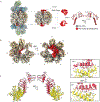Structure of the preholoproteasome reveals late steps in proteasome core particle biogenesis
- PMID: 37653242
- PMCID: PMC10879985
- DOI: 10.1038/s41594-023-01081-w
Structure of the preholoproteasome reveals late steps in proteasome core particle biogenesis
Abstract
Assembly of the proteasome's core particle (CP), a barrel-shaped chamber of four stacked rings, requires five chaperones and five subunit propeptides. Fusion of two half-CP precursors yields a complete structure but remains immature until active site maturation. Here, using Saccharomyces cerevisiae, we report a high-resolution cryogenic electron microscopy structure of preholoproteasome, a post-fusion assembly intermediate. Our data reveal how CP midline-spanning interactions induce local changes in structure, facilitating maturation. Unexpectedly, we find that cleavage may not be sufficient for propeptide release, as residual interactions with chaperones such as Ump1 hold them in place. We evaluated previous models proposing that dynamic conformational changes in chaperones drive CP fusion and autocatalytic activation by comparing preholoproteasome to pre-fusion intermediates. Instead, the data suggest a scaffolding role for the chaperones Ump1 and Pba1/Pba2. Our data clarify key aspects of CP assembly, suggest that undiscovered mechanisms exist to explain CP fusion/activation, and have relevance for diseases of defective CP biogenesis.
© 2023. The Author(s), under exclusive licence to Springer Nature America, Inc.
Conflict of interest statement
Declaration of Interests
The authors declare that they have no conflict of interest.
Figures






References
-
- Rousseau A & Bertolotti A Regulation of proteasome assembly and activity in health and disease. Nat Rev Mol Cell Biol 19, 697–712 (2018). - PubMed
-
- Chen P & Hochstrasser M Autocatalytic subunit processing couples active site formation in the 20S proteasome to completion of assembly. Cell 86, 961–72 (1996). - PubMed
-
- Jager S, Groll M, Huber R, Wolf DH & Heinemeyer W Proteasome beta-type subunits: unequal roles of propeptides in core particle maturation and a hierarchy of active site function. J Mol Biol 291, 997–1013 (1999). - PubMed
-
- Ramos PC, Hockendorff J, Johnson ES, Varshavsky A & Dohmen RJ Ump1p is required for proper maturation of the 20S proteasome and becomes its substrate upon completion of the assembly. Cell 92, 489–99 (1998). - PubMed
-
- Hirano Y et al. A heterodimeric complex that promotes the assembly of mammalian 20S proteasomes. Nature 437, 1381–5 (2005). - PubMed
Publication types
MeSH terms
Substances
Grants and funding
LinkOut - more resources
Full Text Sources
Molecular Biology Databases
Miscellaneous

